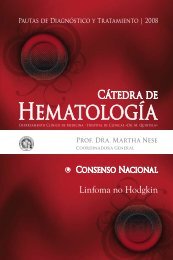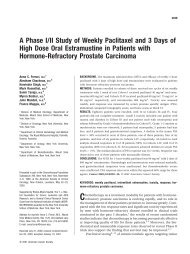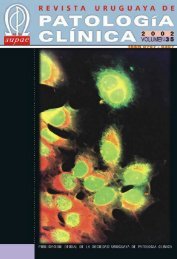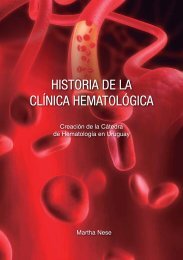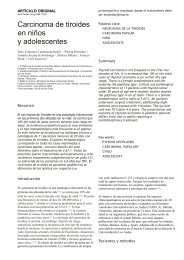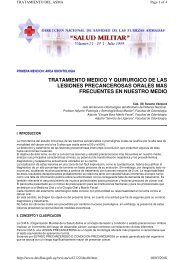Oncologist
Oncologist
Oncologist
Create successful ePaper yourself
Turn your PDF publications into a flip-book with our unique Google optimized e-Paper software.
The<br />
<strong>Oncologist</strong><br />
Physician Education<br />
Mucositis: Its Occurrence, Consequences,<br />
and Treatment in the Oncology Setting<br />
JOSÉ-LUIS PICO, ANDRÉS AVILA-GARAVITO, PHILIPPE NACCACHE<br />
Bone Marrow Transplantation Unit, Institut Gustave Roussy, Villejuif, France<br />
INTRODUCTION<br />
Mucositis induced by antineoplastic drugs is an important,<br />
dose-limiting, and costly side effect of cancer therapy. The<br />
ulcerative lesions produced by mucotoxic chemoradiotherapy<br />
are painful, restrict oral intake and, importantly, act as sites of<br />
secondary infection and portals of entry for the endogenous<br />
oral flora [1]. The overall frequency of mucositis varies and is<br />
influenced by the patient’s diagnosis, age, level of oral health,<br />
and type, dose, and frequency of drug administration [2].<br />
Some degree of mucositis occurs in approximately 40% of<br />
patients who receive cancer chemotherapy [2]. Approximately<br />
one-half of those individuals develop lesions of such severity<br />
as to require modification of their cancer treatment and/or parenteral<br />
analgesia. The condition’s incidence is consistently<br />
higher among patients undergoing conditioning therapy for<br />
bone marrow/peripheral blood progenitor cell transplantation,<br />
continuous infusion therapy for breast and colon cancer, and<br />
therapy for tumors of the head and neck associating concomitant<br />
chemotherapy and radiotherapy. Among patients in the<br />
high-risk protocols, severe mucositis occurs with a frequency<br />
in excess of 60% [3-5].<br />
Concomitant with mucositis is often a chemotherapyinduced<br />
myelosuppression. The neutropenia that results<br />
puts the patient with oral mucositis at significant risk for<br />
systemic infection. Patients with mucositis and neutropenia<br />
have a relative risk of septicemia that is greater than four<br />
times that of individuals without mucositis [6].<br />
The morbidity of all mucositis can be profound. It is estimated<br />
that approximately 15% of patients treated with radical<br />
radiotherapy to the oral cavity and oral pharynx will require<br />
hospitalization for treatment-related complications [7]. In<br />
addition, severe oral mucositis may interfere with the ability<br />
to deliver the intended course of therapy, leading to significant<br />
interruptions in treatment, and possibly impacting on<br />
local tumor control and patient survival. It is also not unusual<br />
for mucositis to necessitate delays in cancer chemotherapy<br />
particularly with those agents that are known to be mucotoxic,<br />
including 5-fluorouracil with or without folinic acid,<br />
methotrexate, doxorubicin, etoposide, melphalan, cytosine<br />
arabinoside and cyclophosphamide.<br />
In addition to its impact on a patient’s treatment course,<br />
on quality of life, and morbidity and mortality, mucositis can<br />
also have a significant economic cost. This is particularly<br />
true in the autologous and allogeneic bone marrow transplant<br />
settings for hematologic malignancies, where the length of<br />
hospital stay may be prolonged due to severe mucositis [8].<br />
ETIOLOGY/PATHOPHYSIOLOGY OF MUCOSITIS<br />
Direct Mucotoxicity<br />
It is generally accepted that oral mucositis results from<br />
the direct inhibitory effects of chemoradiotherapy on DNA<br />
replication and mucosal cell proliferation, resulting in a<br />
reduction in the renewal capabilities of the basal epithelium<br />
(Fig. 1). These events are believed to result in mucosal atrophy,<br />
collagen breakdown, and eventual ulceration [9, 10].<br />
The high rate of cellular replication makes the oral and<br />
lower gastrointestinal mucosa particularly susceptible to<br />
this cytotoxicity [11].<br />
Clinically, the direct mucotoxic effects of chemotherapy<br />
on the oral mucosa begin shortly after therapy has<br />
begun, and peak in severity approximately day 7 or day 10<br />
Downloaded from www.The<strong>Oncologist</strong>.com by on February 25, 2010<br />
Correspondence: José-Luis Pico, M.D., Bone Marrow Transplantation Unit, Institut Gustave Roussy, 39 rue Camille<br />
Desmoulins, 94805 Villejuif, France. Telephone: 33-1-42-11-42-39; Fax: 33-1-42-11-52-21; e-mail: pico@igr.fr<br />
©AlphaMed Press 1083-7159/98/$5.00/0<br />
The <strong>Oncologist</strong> 1998;3:446-451
Pico, Avila-Garavito, Naccache 447<br />
Figure 1. Oral mucositis. Courtesy of Amgen Inc., Thousand Oaks,<br />
California.<br />
of therapy, with eventual resolution occurring within two<br />
weeks. Once lesions develop, they heal more quickly in the<br />
younger population.<br />
Analyses of mucositis have largely been based on observational<br />
data. While there have been suggestions as to the<br />
mechanisms whereby mucositis develops, for the most part<br />
the complete pathophysiology of the condition is largely<br />
undefined. A detailed hypothesis has been proposed as to the<br />
mechanisms by which mucositis develops and heals and it is<br />
based on animal and clinical data, but remains somewhat<br />
speculative [12-14]. Mucositis is assumed to be a four-phase<br />
biologic process which involves an inflammatory/vascular<br />
phase, an epithelial phase, an ulcerative/microbiological<br />
phase, and a healing phase (Table 1).<br />
Each phase is proposed to be independent and is a consequence<br />
of a series of actions mediated by cytokines and<br />
other growth factors, the direct effect of the chemotherapeutic<br />
drug on the epithelium, the oral bacterial flora, and the<br />
status of the patient’s bone marrow.<br />
The initial phase is due to the effect of chemoradiotherapy<br />
in causing the release of cytokines (e.g., interleukin 1 [IL-1])<br />
from the epithelium and the connective tissues [12]. Cytokines<br />
such as tumor necrosis factor and IL-1 can incite an inflammatory<br />
response that may result in increased subepithelial<br />
vascularity. This phase is considered to be relatively acute.<br />
The epithelial phase is likely the best documented, specifically<br />
for those agents that are known to impact dividing cells<br />
of the oral mucosal epithelium (those drugs which target DNA<br />
synthesis, the S phase of the cell cycle). The epithelial phase<br />
may be most profound in terms of production of ulcerative<br />
lesions. Therefore, antimetabolites that are cell-cycle specific<br />
are more mucotoxic than drugs that are cell-cycle nonspecific.<br />
This is supported by the observation that temporarily taking<br />
basal cells out of cycle appears to be mucoprotective, as does<br />
modification of apoptotic cell death [13, 14]. The epithelial<br />
phase is therefore categorized by a reduction of epithelial<br />
renewal which results in atrophy and typically begins about<br />
four to five days after chemoradiotherapy administration.<br />
The ulcerative phase is likely the most symptomatic and<br />
biologically complex of all four phases. It is at this time which<br />
mucositis has the greatest impact on the patient’s well being,<br />
as he or she is now susceptible to infection. As previously<br />
described, the occurrence of breakdown in mucosal barriers<br />
occurs concurrent with neutropenia, thereby putting the<br />
patient at risk of infection through lesions in the oral cavity.<br />
The final hypothesized phase of mucositis regards healing<br />
which includes elements related to cell proliferation and differentiation,<br />
a return to normal of peripheral blood cell counts<br />
and control of the oral bacterial flora. The speed at which this<br />
phase takes place directly affects the duration of the mucositis<br />
condition, but likely not the peak of intensity experienced<br />
by the patient.<br />
Indirect Mucotoxicity: Oral Infections<br />
As part of the ulcerative/microbiological phase, the<br />
myelosuppression and inflammation that lead to the breakdown<br />
of the mucosal barriers, thereby comprising the ability of<br />
the patient to resist entry of pathogens, renders them susceptible<br />
to infection from a number of different sources, including<br />
viral, fungal, and bacterial infections. After chemotherapy, the<br />
Downloaded from www.The<strong>Oncologist</strong>.com by on February 25, 2010<br />
Table 1. The four phases of the biologic process of mucositis<br />
Phase<br />
Inflammatory/vascular<br />
Epithelial<br />
Ulcerative/microbiological<br />
Healing<br />
Cause<br />
Due to the effect of chemoradiation in causing the release of inflammatory cytokines from the epithelium and<br />
the connective tissues. This phase is relatively acute.<br />
Due to cytotoxic agents that target DNA synthesis of the oral mucosal epithelium. This phase is usually the most<br />
profound in terms of production of ulcerative lesions.<br />
Due to breakdown in mucosal barriers. Most symptomatic and biologically complex of the phases. This phase<br />
has the greatest impact on patients’ well-being and risk of infection.<br />
Due to renewed cell proliferation and differentiation, return to normal peripheral blood counts, and control of oral<br />
bacterial flora. The speed at which this phase takes place directly affects the duration of the mucositis condition.
448 Mucositis: Its Occurrence, Consequences, and Treatment in the Oncology Setting<br />
Table 2. WHO rating scale of oral toxicity<br />
Grade<br />
Symptom<br />
0 No symptom<br />
1 Soreness and erythema<br />
2 Erythema, ulcers; can eat solid food<br />
3 Ulcers, requires liquid diet only<br />
4 No possible alimentation<br />
Figure 2. Candidiasis. Courtesy of Amgen Inc., Thousand Oaks,<br />
California.<br />
oral cavity may be secondarily infected by a number of viral<br />
pathogens, including herpes simplex virus (HSV). Oral HSV<br />
is an extremely common infection in the general population,<br />
and in patients who develop mucositis after chemotherapy,<br />
40% to 70% of cultures from oral lesions will demonstrate<br />
HSV [15]. Superficial fungal infections with Candida albicans<br />
can occur frequently in patients receiving chemoradiotherapy<br />
(Fig. 2). It has been reported that 60% to 90% of patients with<br />
cancer will have positive cultures for Candida species [16].<br />
The most common organisms involved in oral bacterial superinfections<br />
include gram negative rods and anaerobes. The<br />
polymicrobial nature of the oral flora makes identification of<br />
bacterial super infections challenging.<br />
TOXICITY SCALES<br />
A major hurdle for researchers investigating mucositis has<br />
been a lack of a definitive technique to appropriately measure<br />
oral mucositis. Over the last 20 years many instruments have<br />
been developed in the literature to document and quantify<br />
changes in the tissues of the oral cavity all in oral function during<br />
and after cancer treatment. These vary from the simple 3<br />
or 4 point “toxicity scales” to detailed and specific inventories<br />
of mucosal events and changes scored for different anatomical<br />
regions of the mouth [17]. There are a number of practical considerations<br />
to be addressed by investigators before selecting a<br />
mucositis scale: Why is mucositis being scored; who will be<br />
scoring the changes, and how often will mucositis be scored<br />
and under what “clinical” conditions<br />
A good scoring system must fulfill two criteria: content<br />
and validity, and inter-user/intra-user reliability. Traditionally<br />
the first criterion has been fulfilled by reviewing the relevant<br />
literature and soliciting the opinions and ideas of experts in<br />
the field. The second criterion is satisfied by demonstrating<br />
the reproducibility of the scoring system when used by the<br />
same person and/or by different individuals over a defined<br />
period of time. A list of the more commonly used mucositis<br />
scoring systems includes the scoring system proposed by the<br />
World Health Organization (WHO) (Table 2), the National<br />
Cancer Institute, the Radiation Therapy Oncology Group, and<br />
the National Cancer Institute of Canada Clinical Trials Group.<br />
The same descriptive terms are used in all of the scales.<br />
However, there are subtle differences which preclude interchangeably.<br />
For example, the symptom of pain, if it is included<br />
in the grading system at all, is described using terms such as<br />
“mild, moderate or severe,” or as “requiring analgesics or<br />
requiring narcotics.” The variations between scales also exist<br />
in the assessment of the impact of mucositis on the patient’s<br />
ability to eat. A lack of agreement also exists regarding the<br />
score attached to a specific sign or symptom complex. All of<br />
these factors contribute to making comparisons between the<br />
scales difficult. Another factor limiting direct comparisons<br />
between scoring systems is the terminology used to describe<br />
signs of mucositis; for example, “mucosal denudation” versus<br />
“spotted or confluent mucositis” versus “ulcer.” Generally, little<br />
information exists regarding validation of these toxicity<br />
scales [18].<br />
It may be difficult to design one single scale for measuring<br />
mucositis that will be appropriate in all clinical situations,<br />
given the diversity of chemoradiotherapy treatments available<br />
and their resulting toxicities. However, with the advent<br />
of new forms of treatment and greater emphasis on assessment<br />
of treatment-related morbidity and mortality, there<br />
exists a strong need for universally accepted, validated scales<br />
to assess mucositis.<br />
In summary, examples of general or overall rating scales<br />
that provide simple 0 to 3 or 0 to 4 mucositis scores which are<br />
based on clinical impressions (e.g., the WHO oral mucositis<br />
scale) are limited. In contrast, scales have been developed that<br />
combine detailed mucosal change descriptors with various<br />
subjective (e.g., pain) and performance criteria (e.g., speaking,<br />
swallowing). The oral assessment guide developed by<br />
Eilers et al. [19] consists of eight categories—voice, swallow,<br />
lips, tongue, saliva, mucous membranes, gingiva, and tooth—<br />
that are rated using a 1 (normal) to 3 (definitively compromised)<br />
scale. These more detailed scales have received less<br />
Downloaded from www.The<strong>Oncologist</strong>.com by on February 25, 2010
Pico, Avila-Garavito, Naccache 449<br />
experience in the clinical trial setting and frequently require<br />
the training of specialized oral cavity experts to provide<br />
consistency in mucositis assessment.<br />
PREDICTIVE INDICES/RISK FACTORS<br />
Patient-Related Risks<br />
A variety of patient-related factors appears to increase the<br />
potential for developing mucositis after chemoradiotherapy,<br />
including the age of the patient, nutritional status, type of<br />
malignancy, pretreatment oral condition, oral care during<br />
treatment, and pretreatment neutrophil counts. There are conflicting<br />
data relating to the effects of age and the development<br />
of chemotherapy-induced mucositis [20]. In general, younger<br />
patients appear to have an increased risk of chemotherapyinduced<br />
mucositis. This observation may be explained by the<br />
more rapid epithelial mitotic rate or the presence of more epidermal<br />
growth factor receptors in the epithelium of younger<br />
patients. Alternatively, the physiologic decline in renal function<br />
associated with aging may result in older patients<br />
being at higher risk of chemotherapy-induced mucositis.<br />
Hematologic malignancies are relatively more frequent in<br />
children than adults, and their treatments tend to produce<br />
more prolonged and intense myelosuppression, which may<br />
also result in more severe indirect mucotoxicity.<br />
Other patient-related factors include chronic periodontal<br />
disease, pretreatment xerostomia which may contribute significantly<br />
to the development of oral mucositis, and any decrease<br />
in neutrophil count before chemotherapy. The latter may result<br />
in an impaired ability to mount an adequate inflammatory<br />
response to the cytotoxic effects of chemotherapy on the oral<br />
mucosa.<br />
Therapy-Related Risks<br />
In conjunction with patient-related factors, factors that<br />
are treatment-related include specific chemotherapeutic<br />
drug, dose, schedule, and use of radiation therapy [21]. All of<br />
these will affect the subsequent development (severity and<br />
duration) of mucositis. Protracted infusions of antimetabolites,<br />
as well as concomitant use of radiation, result in more<br />
severe mucositis [22]. Certain chemotherapeutic agents such<br />
as methotrexate and etoposide may also be secreted in the<br />
saliva, leading to increased direct mucotoxicity.<br />
Risks are summarized in Table 3.<br />
PREVENTION AND PROPHYLAXIS<br />
Many traditional treatments are ineffective. The basic principles<br />
of mouth care—to relieve pain, prevent dehydration,<br />
provide adequate nutrition, and deal with any focus of infection<br />
such as obvious candidiasis—stand the test of time.<br />
Approaches to the prevention of mucositis induced by<br />
chemoradiotherapy can be divided into three broad categories:<br />
A) alteration of the mucosal delivery and excretion of<br />
individual chemotherapeutic agents; B) modification of the<br />
epithelial proliferative capabilities of the mucosa, and C)<br />
alteration of the potential for infections of inflammatory<br />
complications.<br />
Some mucosal pharmacologic alterations that have been<br />
tried include cryotherapy [20, 23], allopurinol [24], propantheline<br />
[25], and pilocarpine [22]. The results have generally<br />
been mixed, but the studies have been pilot ones in a small<br />
number of patients, so conclusions are hard to draw.<br />
Mucosal Proliferation Modifiers<br />
It has been suggested that the rate of basal epithelial cell<br />
proliferation correlates with susceptibility with mucosal tissues<br />
with the toxic effects of chemotherapy [26]. Therefore,<br />
investigators have studied various agents that impact epithelial<br />
proliferation to identify a means of preventing chemotherapy-induced<br />
mucositis, including beta-carotene, glutamine,<br />
cytokines, dinoprostone, and silver nitrate. Preliminary results<br />
with many cytokines have been presented in the literature;<br />
however, to date, none of them have proven themselves in<br />
randomized, double-blind, placebo-controlled, registration<br />
trials [22].<br />
Anti-Microbial/Anti-Inflammatory Approaches<br />
Clinical trials have established that a combination of<br />
correction of existing oral conditions before therapy and<br />
aggressive mouth care can reduce the incidence and severity<br />
of oral mucositis following chemotherapy [27]. In addition<br />
to appropriate oral hygiene, trials investigating oral antimicrobial<br />
agents for the prevention of chemotherapy-induced<br />
mucositis have provided conflicting data. Studies conducted<br />
with lozenges composed of polymyxin B, Tobramycin, and<br />
amphotericin B provide some benefit in mucositis prevention<br />
in patients receiving head and neck irradiation.<br />
Table 3. Risk factors for mucositis<br />
Patient-Related Factors<br />
▲ Type of malignancy: hematologic malignancies pose greater<br />
risk than solid tumors.<br />
▲ Patients
450 Mucositis: Its Occurrence, Consequences, and Treatment in the Oncology Setting<br />
However, these data require confirmation. Finally, steroid<br />
mouthwashes have not been formally investigated for the<br />
prevention of chemotherapy-induced mucositis. The ability<br />
of corticosteroids to inhibit prostaglandin synthesis, combined<br />
with data from small uncontrolled trials in patients<br />
receiving radiation, does provide a hypothesis for further<br />
study of these agents [22].<br />
In summary, the management of established mucositis<br />
can be difficult for both the patient and the provider. General<br />
approaches include effective oral care, dietary modifications<br />
and topical mucosal protectants. In addition, appropriate use<br />
of topical anesthetics and systemic analgesics remain the<br />
cornerstone of therapy. Promising agents that accelerate<br />
mucosal healing and alter the course of the biologic process<br />
of mucositis are under investigation, like the keratinocyte<br />
growth factor [28]. The use of such agents in many settings,<br />
including head and neck cancer and bone marrow transplantation,<br />
promises to substantially reduce treatment-related<br />
morbidity, improve patient quality of life, and potentially<br />
allow treatment intensification in high-risk disease.<br />
ACKNOWLEDGMENT<br />
Robert Heard, Ph.D., assisted with the writing of this<br />
manuscript.<br />
REFERENCES<br />
1 Sonis S, Clark J. Prevention and management of oral mucositis<br />
induced by antineoplastic therapy. Oncology 1991;5:11-18.<br />
2 Sonis S. Oral complications. In: Holland JF, Frei E III, Bast<br />
RC Jr., eds. Cancer Medicine, 4th Edition. Philadelphia: Lea<br />
& Febiger 1997;3255-3264.<br />
3 Schubert M, Sullivan K, Truelove E. Head and neck complication<br />
of bone marrow transplantation. Development Oncology<br />
1991;36:401-427.<br />
4 Woo SB, Sonis ST, Monopoli MM et al. A longitudinal study of<br />
oral ulcerative mucositis in bone marrow transplant recipients.<br />
Cancer 1993:72:1612-1617.<br />
5 McGuire DB, Altomonte V, Peterson DE et al. Patterns of<br />
mucositis and pain in patients receiving preparative chemotherapy<br />
and bone marrow transplantations. Oncol Nurs Forum<br />
1993;20:1493-1502.<br />
6 Elting LS, Bodey GP, Keefe BH. Septicemia and shock syndrome<br />
due to viridans streptococci: a case control study of<br />
predisposing factors. Clin Infect Dis 1992;14:1201-1207.<br />
7 Peters LJ, Ang KK, Thames HD. Altered fractionation schedules.<br />
In: Perez CA, Brady LW, eds. Principles and Practice of<br />
Radiation Oncology. Philadelphia: JB Lippincott 1992;97-113.<br />
8 Ruescher TJ, Sodeifi A, Scrivani SJ et al. The impact of mucositis<br />
on alpha-hemolytic streptococcal infections in patients undergoing<br />
autologous bone marrow transplantation for hematologic<br />
malignancies. Cancer 1998;82:2275-2281.<br />
9 Guggenheimer J, Verbin RS, Apple BN et al. Clinco-pathologic<br />
effects of cancer chemotherapeutic agents on human buccal<br />
mucosa. Oral Surg Oral Med Oral Pathol 1997;44:58-63.<br />
10 Lockhart PB, Sonis ST. Alterations in the oral mucosa caused by<br />
chemotherapeutic agents. A histologic study. J Dermatol Surg<br />
Oncol 1981;7:1019-1025.<br />
11 Squier CA. Mucosal alterations. NCI Monograph<br />
1990;9:169-172.<br />
12 Sonis ST. Mucositis as a biological process: a new hypothesis<br />
for the development of chemotherapy-induced stomatotoxicity.<br />
Oral Oncol 1998,34:39-43.<br />
13 Sonis ST, Lindquist L, VanVugt A et al. Prevention of<br />
chemotherapy-induced ulcerative mucositis by transforming<br />
growth factor beta 3. Cancer Res 1994:54:1135-1138.<br />
14 Cope PO, DeMeo M, Stiff P et al. Prophylactic enteral support<br />
to BMT patients reduces length of hospital stay,<br />
improves GI integrity and nutritional status, and reduces<br />
intake requirements required for positive outcome. Proc<br />
ASCO 1997;16:218a.<br />
15 Greenberg MS, Friedman H, Cohen SG et al. A comparative<br />
study of herpes simplex infections in renal transplant and<br />
leukemic patients. J Infect Dis 1987;156:280-287.<br />
16 Yeo E, Alvarado T, Fainstein V et al. Prophylaxis of<br />
oropharyngeal candidiasis with clofrimazole. J Clin Oncol<br />
1985;3:1668-1671.<br />
17 Schubert MM. Measurement of oral tissue damage and mucositis<br />
pain. In: Chapman CR, Foley KH, eds. Current and Emerging<br />
Issues on Cancer Pain: Research and Practice. New York: Raven<br />
Press 1993;247-265.<br />
18 Parulekar W, Mackenzie R, Bjarnason G et al. Scoring oral<br />
mucositis. Oral Oncol 1998:34:63-71.<br />
19 Eilers J, Berger A, Petersen M. Development, testing, and<br />
application of the oral assessment guide. Oncol Nurs Forum<br />
1988;15:325-330.<br />
20 Mahood DJ, Dose AM, Loprinzi CL et al. Inhibition of 5-fluorouracil-induced<br />
mucositis by oral cryotherapy. J Clin Oncol<br />
1991;9:449-452.<br />
21 Borowski B, Benhamou E, Pico JL et al. Prevention of oral<br />
mucositis in patients treated with high-dose chemotherapy and<br />
bone marrow transplantation: a randomized controlled trial comparing<br />
two protocols of dental care. Oral Oncol, Eur J Cancer<br />
1994;30B:93-97.<br />
22 Wilkes JD. Prevention and treatment of oral mucositis following<br />
cancer chemotherapy. Semin Oncol 1998;25:538-551.<br />
23 Rocke LK, Loprinzi CL, Lee JK et al. A randomized clinical trial<br />
of two different durations of oral cryotherapy for prevention of<br />
5-fluorouracil-related stomatitis. Cancer 1993;72:2234-2238.<br />
Downloaded from www.The<strong>Oncologist</strong>.com by on February 25, 2010
Pico, Avila-Garavito, Naccache 451<br />
24 Loprinzi CL, Cianflone SG, Dose AM et al. A controlled evaluation<br />
of an allopurinol mouthwash as prophylaxis against<br />
5-fluorouracil-induced stomatitis. Cancer 1990;65:1879-1882.<br />
25 Ahmed T, Engelking C, Szalyga J et al. Propantheline prevention<br />
of mucositis from etoposide. Bone Marrow Transplant<br />
1993;12:131-132.<br />
26 Sonis ST, Costa JW, Evitts SM et al. Effect of epidermal<br />
growth factor on ulcerative mucositis in hamsters that receive<br />
cancer chemotherapy. Oral Surg Oral Med Oral Pathol<br />
1992;74:749-755.<br />
27 Beck S. Impact of a systematic oral care protocol on stomatitis<br />
after chemotherapy. Cancer Nurs 1979;2:185-199.<br />
28 Serdar C, Heard R, Parthikanti E et al. Safety, pharmacokinetics<br />
and biologic activity of rHuKGF in normal volonteers: results of<br />
placebo-controlled, randomized double-blind phase I study.<br />
Blood 1997;90(suppl 1):172a.<br />
Downloaded from www.The<strong>Oncologist</strong>.com by on February 25, 2010
Mucositis: Its Occurrence, Consequences, and Treatment in the Oncology Setting<br />
José-Luis Pico, Andrés Avila-Garavito and Philippe Naccache<br />
<strong>Oncologist</strong> 1998;3;446-451<br />
This information is current as of February 25, 2010<br />
Updated Information<br />
& Services<br />
including high-resolution figures, can be found at:<br />
http://www.The<strong>Oncologist</strong>.com/cgi/content/full/3/6/446<br />
Downloaded from www.The<strong>Oncologist</strong>.com by on February 25, 2010



